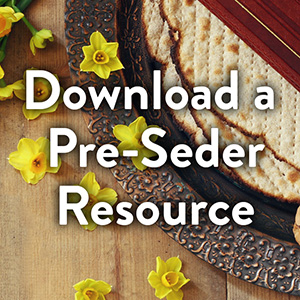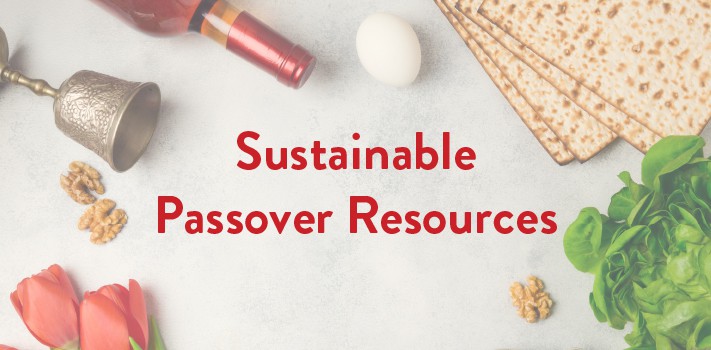When is Passover?
In 2022 it will be from sundown on Friday, April 15 through sundown on Saturday, April 23.
In 2023 it will be from sundown on Wednesday, April 5 through sundown on Thursday, April 13.
In 2024 it will be from sundown on Monday, April 22 through sundown on Tuesday, April 30.
What is Passover?
Passover or Pesach starts the 15th of Nissan and celebrates the exodus of the Israelites from Egypt. For 8 days we celebrate our liberation from slavery and our journey to freedom. On the first night of Passover we remember the sacrifice of lamb and on the second night the sacrifice of barley – each to remind us of temple celebrations that connect us to the land of Israel. Passover is a time to notice and celebrate the coming of spring. The seder plate abounds with seasonal symbols: the roasted lamb bone celebrates lambs born in spring; karpas (dipped green vegetables) symbolizes the first green sprouts peeking out of the thawed ground, and a roasted egg recalls fertility and rebirth.
How can I make my Passover seder more sustainable? Check out the tabs below for tips, recipes, and resources for crafting a greener holiday experience!
Hazon has two Passover supplements available for free download:

(NEW) Pre-seder supplement: Setting a Conscious Table
As you prepare for the Passover seder this year, consider using these four questions to help inform your own conscious food choices, and to enhance your discussions with family and friends during the holiday. This resource was created in collaboration with Jewish Initiative for Animals (JIFA).
 Seder supplement: Higher Welfare Eggs
Seder supplement: Higher Welfare Eggs
Passover offers a perfect opportunity to combine the wisdom of a traditional Jewish holiday with our contemporary desire to live with our health and sustainability in mind. This year, use Hazon and JIFA’s Higher Welfare Egg Haggadah Supplement to start a discussion about animal welfare at your seder.
Food & Recipes
A Sustainable Seder Meal
Host a vegetarian or vegan seder. Even if you regularly eat meat, Passover is a great time to eat lower on the food chain. Think of it as getting rid of your “gastronomical chametz.” Menu ideas: quinoa salad, matzah tortillas, vegetarian matzah ball soup, creamy asparagus soup, roasted new potatoes with rosemary, Israeli salad, borscht… the possibilities are endless!
The Shamayim blog has an incredible bank of resources and recipes for a vegan seder.
Jewish Veg has great videos (including one with Mayim Bialik), a vegan haggadah, and loads of Passover recipes on their website.
Host a potluck seder. Or at least accept offers of help with the preparation. A sustainable seder also means not wearing out the host!
Bring on the hors d’oeuvres. After you bless and eat the karpas, vegetables and dip, fruits, and cheese are all permitted. Save your table from starvation and distraction with a few snacks – everyone will have a better time.
Buy vegetables at your farmer’s market. Go a few weeks early and chat with the sellers to see what they’ll have available at seder time. In many parts of the country, options will be slim, but you may find salad greens, cabbage, fiddleheads, spinach, as well as root vegetables in cold storage (carrots, potatoes, onions, squash, beets) and apples and pears. Consider making at least one dish from all local ingredients and feature it at your seder.
Serve local and/or organic wine. Find out ahead of time what your local wine store has in stock—especially if you plan to buy a lot of bottles. If they don’t have anything, ask them to order a case on your behalf. There aren’t many kosher organic wines available, but one or two are Kosher for Pesach. Consider paying a little more at a locally-owned store; sustainable means supporting local businesses, too.
Serve local/ethically-sourced meat. Meat dishes like chicken soup with matzah balls and brisket are traditional favorites for Passover. Try buying your meat from the person who raised it (or as close to that as possible. Where to shop: farmer’s markets, meat co-ops, local butcher shops (ask them where the meat comes from).
A Sustainable Seder Plate
Higher Welfare beytza (egg). Buy higher-welfare eggs that are labeled “Certified Humane” or, even better “Certified Humane + Pasture Raised” or “Animal Welfare Approved.” Buying eggs with these third-party certifications means supporting healthy hens and farmers who are making it possible for you to eat good food. Discuss your decision to buy a higher welfare egg at your Seder using Hazon’s higher welfare egg Haggadah supplement.
Sprout your own Karpas. If you can’t find locally grown greens to dip for karpas, sprout your own! Although many sprouts come from corn, soybeans, and other chametz or kitnyot, in just 2-3 days, you can have fresh, delicious quinoa sprouts that you “grew” yourself! If you started a home-grown garden during Tu B’Shvat, now is the time to dig into that garden and make use of your home grown parsley.
Horseradish doesn’t grow in a bottle. Buy and grate fresh horseradish root for maror on your seder plate. When it comes time for the Hillel sandwich, hold up an ungrated root so your guests know where that bitter stuff comes from. Or make your own. You can also incorporate horseradish into your seder in other ways, or use leftover horseradish for meals throughout Passover. You can try incorporating horseradish in salads, side dishes, and even drinks!
Roast a beet. If you’re going vegetarian for your seder (see below), substitute a roasted beet for the roasted lamb shank. Or follow The Jew & The Carrot reader, Sarah Fenner’s suggestion: “In place of the shankbone in my home, we have often roasted a “pascal yam” instead!”
Make your own Matzah. It only takes 18 minutes. Try making Matzah at home with kids.
Every Charoset tells a story. Charoset’s mixture of apples and nuts is already healthy and delicious and, when made with local apples, sustainable. Charoset also offers you the chance to explore other cultures within the Jewish Diaspora. Check out the Jew & the Carrot to find recipes from Russia, Spain, Holland, Yemen, Turkey, Surinam… – or ask your guests to bring their own favorite charoset recipe and have a taste-test. Check out this delicious Sephardic Charoset recipe!
Charoset Recipes from Around the World
Moroccan Charoset
Moroccan Jews settled in Morocco, located near the northern tip of Africa that is closest to Spain, after the destruction of the Temple in 70 CE. The Jewish population in Morocco has been a vibrant and active population, but after the founding of the State of Israel, many of the 265,000 Moroccan Jews emigrated to Israel and the United States. As of 2004, Morocco had a population of about 4,000 Jews; meanwhile Israel is home to nearly 1,000,000 Jews of Moroccan descent, around 15% of the nation’s total population.
- 1 3/4 cups dates
- 1 3/4 cups dried figs
- 1/4 cup wine
- 1 cup almonds
- 1/2 cup raisins
- 2 tbsp powdered sugar
- 1 tsp cinnamon
- 1/2 tsp nutmeg
Pit and chop dates, and chop figs. Then throw it all in the food processor and chop into a paste! Optional: roll charoset into little balls to serve.
Ashkenazi Apple-Nut Charoset
Ashkenazi Jews trace their lineage back to the medieval Jewish communities of Eastern Europe, and their traditions have developed to be distinctly influenced (to varying degrees) by interaction with surrounding peoples, such as the Germans, Poles, Czechs, Slovaks, Kashubians, Hungarians, Ukrainians, Lithuanians, Latvians, Belarusians and Russians of contemporary Eastern Europe. Today, Ashkenazi Jews make up 80% of Jews worldwide, and 6 million of the 7 million Jews living in the United States.
- 2 Granny Smith apples
- 2 cups almonds, chopped
- ½ cup sweet Passover wine
- 2 tsp cinnamon
Peel, core, and dice apples. Chop nuts (should be slightly smaller pieces than the apples). Add wine and cinnamon; adjust quantities to taste!
Israeli Charoset
Israeli Jews either live in Israel or have had family in the Middle Eastern state since Israel’s founding in 1948. Currently, Jews account for 76.4% of the Israeli population, and many of them are recent immigrants. Between 1974 and 1979 nearly 227,258 immigrants arrived in Israel, about half being from the Soviet Union. This period also saw an increase in immigration to Israel from Western Europe, Latin America, and the United States. A trickle of immigrants from other communities has also arrived, including Indian Jews, Ethiopian Jews, and others.
- 2 apples, chopped
- 6 bananas, mashed
- 1 lemon, juiced and grated
- 1 orange, juiced and grated
- 1 1/4 cups dates, chopped
- 1 cup red wine
- 4 tsp candied orange peel, chopped
- 1 cup walnuts, chopped
- Matzah meal
- Cinnamon
- Sugar
Blend the fruits and nuts. Add wine. Add as much matzah meal as the mixture will take and still remain soft. Add cinnamon and sugar to taste. Mix well and chill before serving.
Yemenite Charoset
Yemenite Jews are those Jews who live or whose family has lived in Yemen, on the southern tip of the Arabian peninsula. The immigration of Jews into Yemen can be traced back to about the beginning of the second century CE, but between June 1949 and September 1950 almost the entire Jewish population left Yemen for Israel. Most Yemenite Jews now live in either Israel or the United States. Only a few remain in Yemen, and most of them are elderly.
- 1 lb. dried raisins
- 8 oz. pitted dates
- 1/4 cup sugar
- 1/4 cup chopped walnuts or pecans
- 2 cups water
Put raisins and dates in a bowl and cover with water. Let stand one hour. Add the sugar and whirl the mixture in a blender, a few spoonfuls at a time, or divide the mixture in thirds and place in a food processor. Transfer the chopped fruits to a heavy saucepan and let simmer over low heat until the fruits are cooked and the liquid is absorbed. It should take about 20 minutes. Remove from the heat and place in a jar.
Venetian Charoset
Venetian Jews are those Jews who live in or are from Venice, a city in northern Italy. Many Jews visited and worked in Venice beginning in the 10th century CE; and at its peak time, around 1650, the Venetian Ghetto (where the Jews were forced to live) housed about 4,000 people. Before World War II there were still about 1,300 Jews in the Ghetto, but 289 were deported by the Nazis and only seven returned. Today, the Ghetto is still a center of Jewish life in Venice, with five synagogues, a yeshiva, and Judaica shops.
- 1 1/2 cups chestnut paste
- 1/2 cup pine nuts
- 10 oz. dates, chopped
- Grated rind of one orange
- 12 oz. figs, chopped
- 1/2 cup white raisins
- 2 tbsp poppy seeds
- 1/4 cup dried apricots
- 1/2 cup chopped walnuts
- 1/2 cup brandy
- 1/2 cup chopped almonds
- Honey to bind
Combine all ingredients, gradually adding just enough brandy and honey to make the mixture bind. Other Italian charoset recipes include mashed-up bananas, apples, hard-boiled eggs, crushed matzah, pears, and lemon.
Moroccan Charoset Balls By Susan Barocas
Activities & Rituals
Consider the Egg. The egg on the Seder plate is often overlooked. This Passover, use Hazon’s higher welfare egg Haggadah supplement to start a conversation about Jewish tradition and animal welfare.
Host a chocolate seder. Use this Haggadah supplement for a discussion around sustainability, worker justice, and related food issues. A Haggadah for a Chocolate Seder is a supplement to the book On the Chocolate Trail.
The Fast Food of Pesach. Think of Matzah as a “fast food” and have a food access conversation. What are the reasons that Matzah could be considered a “fast food”? Use this Haggadah supplement from Hazon and Repair the World to start a conversation about food access at your seder.
Food and Justice. The Uri L’Tzedek Food and Justice Haggadah Supplement features essays, insights and action to unite food, social justice, and ethical consumption.
Food Blessings. Recount the many food blessings in Jewish tradition. Invite each guest to offer a food blessing – either traditional and original, This is a good way to consider all of the food that we will eat together during the Pesach seder, and what the significance may be to each individual at the table.
Place an ice block on your seder table. Open up a conversation about the climate crisis, while linking it to the fundamental themes of Pesach and Jewish community life. As the ice block melts throughout the seder, it becomes a physical prompt to ask questions, much like many of the other items on the seder table. Download Jewish Climate Network’s Supplement here.
What Would Moses Do? Moses brought the enslaved Jews out of Egypt towards freedom. Sadly, a different form of slavery exists today, both in Israel and the rest of the world. According to estimates by NGOs, a few hundred to a few thousand people have been illegally trafficked into Israel for sexual exploitation or labor. Approximately 70% of these sex workers are women. Refer to Fair Trade Judaica’s Seder Resources to educate your guests about the slavery that exists in the world today.
Buying Fair Trade products helps ensure that producers around the world were not forcibly enslaved and have fair working conditions. Did you know that there are no fair trade, kosher-certified chocolates available for Passover? Join with Fair Trade Judaica in their campaign advocating for fair trade chocolate, so that you can enjoy chocolate during Passover while knowing that the workers producing the chocolate were granted fair working conditions.
Suggestions from Fair Trade Judaica:
- Place a Virtual Fair Trade Chocolate bar on your Seder plate and talk about child labor as a modern day form of slavery
- Read this Passover Seder Supplement to highlight the labor issues related to chocolate
- Choose fair-trade certified quinoa or rice for those who observe Sephardi Passover dietary restrictions
Sustainability Tips
Pre-Passover Green Cleaning. You don’t have to douse your house in poisonous chemicals—noxious to both you and the people who work in the factories that produce them—to get rid of your chametz (bread products and crumbs which are literally, and ritually, cleared before Pesach). Try using natural, non-toxic cleaning products instead of your traditional harsh chemicals.
Plan ahead. In the time leading up to Pesach, be mindful of what you buy. Try to finish those “almost empty” containers in your fridge, and half empty bags of bread, rather than automatically resorting to buying new. You can get rid of chametz in the most sustainable and cost effective way by planning ahead in order to use up as much as you can of what you have before the start of Pesach.
Invest in Pesach Dishware. Pesach is a time when many families break out the fine china and heirloom silverware. Investing in a set of Pesach dishware, is a sustainable commitment to avoid buying disposables every year. If you’re using disposable plates this year, use post-consumer waste paper or plant-based ones. For some great compostable disposable dishwear products, check out Leafware, Go Green in Stages, Let’s Go Green, and World Centric.
Get rid of ALL your chametz. Chametz isn’t just leavened bread – it is a symbol for all the unnecessary waste that fills up our lives. While you’re getting rid of breadcrumbs, read the ingredients on your food. All those sauces that are different versions of sugar – do you really need them? If you’re feeling brave: cut out caffeine and all processed foods, and maybe give up booze for good measure. Your body will thank you. You’ll go into Pesach feeling strong and clean.
What’s your existential chametz? Start journaling. What’s the fluff, the stuff, the superfluity, that clogs up your brain, that stops you being free?
Enjoy your flowers on Pesach—and all spring. Fresh bouquets make beautiful centerpieces, but only last a few days, and are often grown with pesticides. Try a sustainable alternative like potted tulips. Potted herbs also make a beautiful, inexpensive centerpiece, and make your table smell great! You can buy potted thyme, rosemary, lavender, and other fragrant herbs at a garden nursery or farmer’s market. At the end of the seder, give your centerpieces as gifts to your guests. If you definitely want cut-flower centerpieces, go organic!
Dig In
Hazon Resources
Food for Thought– A 130-page sourcebook that draws on a range of texts from within and beyond Jewish traditions to explore a range of topics relating to Jews and food.
Hazon Food Guide– The Hazon Food Guide and Food Audit Toolkit will help you navigate food choices in your synagogue or JCC, and offer practical suggestions for bringing our ancient tradition of keeping kosher–literally, eating food that is “fit”– to bear on the range of food choices we’re making today.




